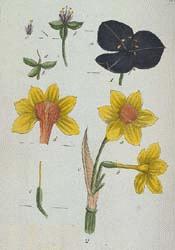
Botanical.com Home Page
NarcissusFamily: N.O. Amaryllidaceae
The bulbs of plants belonging to the natural order Amaryllidaceae are in many cases poisonous, though they are widely cultivated for the sake of their flowers. The chief of these is the DAFFODIL, or Lent Lily (Narcissus pseudo-narcissus, Linn.). The botanical name of the genus, Narcissus, is considered to be derived, not as is often said, from the name of the classical youth who met with his death through vainly trying to embrace his image reflected in a clear stream, but from the Greek word narkao (to benumb), on account of the narcotic properties which the plant possesses. Pliny describes it as Narce narcissum dictum, non a fabuloso puero, 'named Narcissus from Narce, not from the fabulous boy.' Socrates called this plant the 'Chaplet of the infernal Gods,' because of its narcotic effects. An extract of the bulbs, when applied to open wounds, has produced staggering, numbness of the whole nervous system and paralysis of the heart. The popular English names Daffodowndilly, Daffodily Affodily, are a corruption of Asphodel, with which blossoms of the ancient Greeks this was supposed to be identical. It is in France the fleur d'asphodèle, also 'pauvres filles de Sainte Claire.' Herrick alludes in his Hesperides to the Daffodil as a portent of death, probably connecting the flower with the asphodel, and the habit of the ancient Greeks of planting that flower near tombs. The bulbs of the Daffodil, as well as every other part of the plant are powerfully emetic, and the flowers are considered slightly poisonous, and have been known to have produced dangerous effects upon children who have swallowed portions of them. The influence of Daffodil on the nervous system has led to giving its flowers and its bulb for hysterical affections and even epilepsy, with benefit. A decoction of the dried flowers acts as an emetic, and has been considered useful for relieving the congestive bronchial catarrh of children, and also useful for epidemic dysentery. In France, Narcissus flowers have been used as an antispasmodic. A spirit has been distilled from the bulb, used as an embrocation and also given as a medicine and a yellow volatile oil, of disagreeable odour and a brown colouring matter has been extracted from the flowers, the pigment being Quercetin, also present in the outer scales of the Onion. The Arabians commended the oil to be applied for curing baldness and as an aphrodisiac. An alkaloid was first isolated from the bulbs of N. pseudo-narcissus by Gerard in 1578, and obtained in a pure state as Narcissine by Guérin in 1910. The resting bulbs contain about 0.2 per cent and the flowering bulbs about 0.1 per cent. With cats, Narcissine causes nausea and purgation. N. princeps also contains a minute quantity of this alkaloid. A case of poisoning by Daffodil bulbs, cooked by mistake in the place of leeks, was reported from Toulouse in 1923. The symptoms were acute abdominal pains and nausea, which yielded to an emetic. The bulbs of N. poeticus (Linn.), the POET'S NARCISSUS, are more dangerous than those of the Daffodil, being powerfully emetic and irritant. The scent of the flowers is deleterious, if they are present in any quantity in a closed room, producing in some persons headache and even vomiting. The bulb is used in homoeopathy for the preparation of a tincture. From the fragrant flowers of the JONQUIL (N. jonquilla) and the CAMPERNELLA (N. odorus), a sweet-smelling yellow oil is obtained in the south of France, used in perfumery. The ease with which most species of Narcissus can be grown in this country is remarkable, since, being mostly natives of Southern Europe and Northern Africa, they have to adapt themselves to very different conditions of soil and climate. No genus of flowering plants is more readily cultivated and less liable to disease, and the presence in its leaves and roots of innumerable bundles of needle-shaped crystals of calcium oxalate, termed raphides, protect it from injury of browsing and gnawing animals, rendering the plants indigestible and possibly poisonous to cattle and smaller animals. The Crocus and Lily are not thus equipped for defence against browsing animals. Rabbits often fall prey to it. The only insect enemy from which the Narcissus seems to suffer is the fly Merodon equestris, the grub of which lays an egg in or near the bulb, which then forms the food of the larva. This pest causes serious damage in Holland and the south of England. See DAFFODIL. [Top] © Copyright Protected 1995-2025 Botanical.com
|
